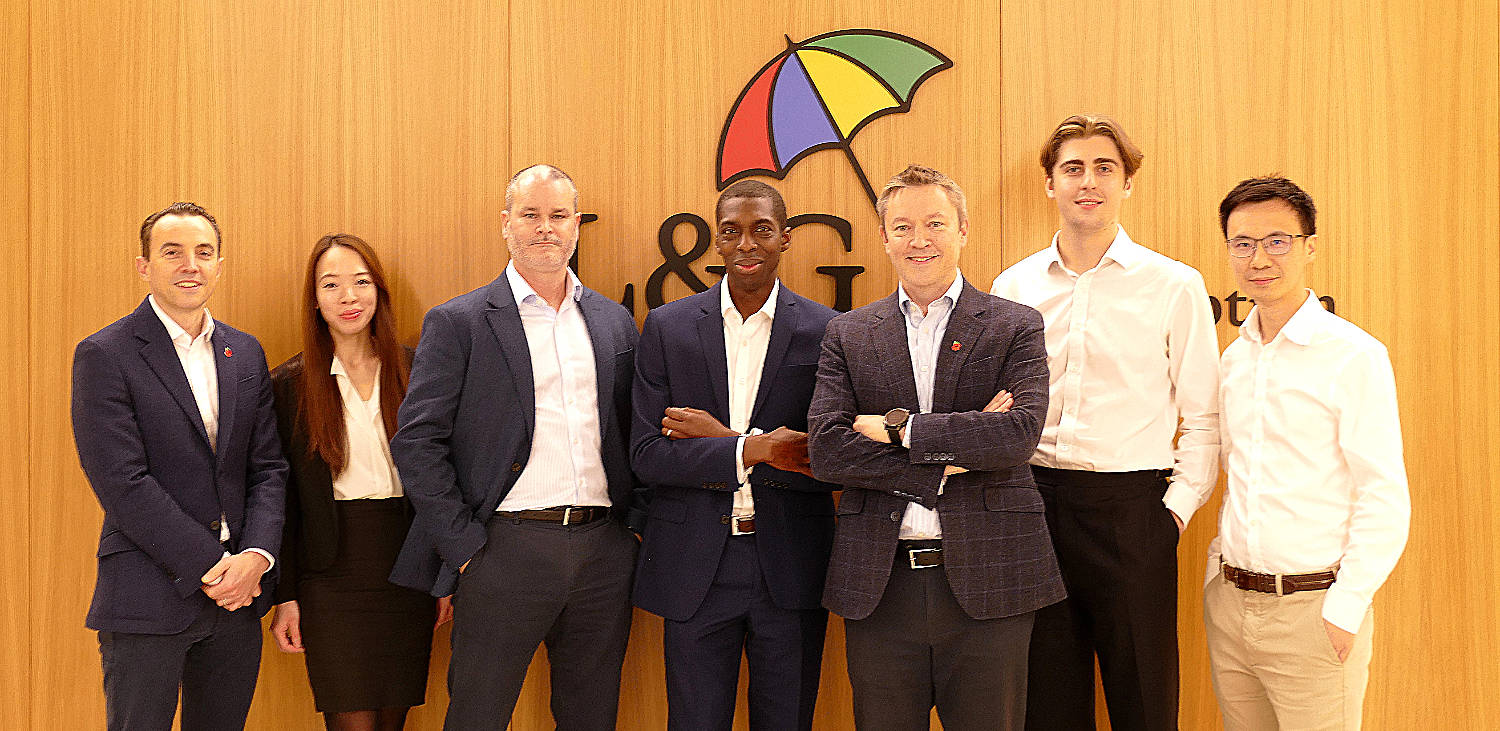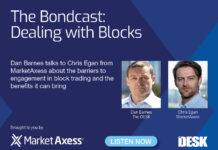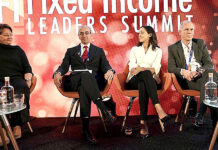
Ed Wicks, L&G Asset Management’s head of trading, sat down with The DESK to discuss how the company organises its operations, the trends he sees across fixed income markets, and what he looks for in up-and-coming traders.
The DESK: You mentioned in our prep call that your role has four pillars. Could you explain what each of those are?
EW: It’s an interesting setup, at L&G. My team is called global trading and liquidity management, and we are essentially responsible for all of L&G’s market facing activities within the Asset Management division. There are four main activities that we cover within my team.
There’s global trading, obviously, and we’ve got desks across the globe for that in Hong Kong, London and Chicago. We use a follow-the-sun approach, passing the book between us.
There’s cash management, which is our money market and ultra-short duration bond portfolio fund management. That has more than £50 billion in assets under management.
Then there’s the securities lending team, which does what it says on the tin. Those are both revenue centres. More recently we have also taken on the ETF capital markets function.”
Those four principal activities that we cover are highly synergistic in how they overlap. A lot of it is around counterparty management, and it’s all market-facing.
There are 42 of us in the team globally covering trading, cash management, securities lending and ETF capital markets.
We’re gradually building out these four functions in each region. For example, our USD liquidity fund, our money market fund, is now co-managed from London and Chicago. We’re exporting what we do in London to our other regions.
What instruments do you cover in London? How are the desks set up?

EW: In London and Chicago, the trading structure is broadly split into two desks: equity/FX and fixed income.
We cover everything at L&G. We often talk about having a barbell approach, with everything from index on one side to private markets on the other. Within that context, we trade absolutely everything – from the most common spot FX to 30-year OTC bilateral rates swaps on behalf of our LDI and insurance clients.
The way we structure that is by having a fixed income trading desk, covering credit, rates and associated derivatives, and an equity and FX trading desk. That structure is replicated in Chicago. There’s no P&L attributed to the desk. Obviously, we’re very focused on performance, we spend a lot of time on analytics and TCA, making sure that we, the investors and the portfolio managers understand the value that we’re bringing to portfolios and, ultimately, to clients.
The Hong Kong office is structured slightly differently. That’s our smallest and newest trading operation, opened in 2017. It has more of a multi-asset approach, which suits the size of the operation and demands of our portfolios in the region. We have people who specialise in a given asset class in HK, but they’ll also be able to cover others if there’s heightened business, or staff absence.
TD: You mentioned taking a follow-the-sun approach. Do you think you’ll have to adapt at all to continuous or 24/7 trading, if it is implemented?
EW: There’s been a lot written about 24/7 trading in recent times. I’ve definitely looked at it. I think the majority of the demand has a retail focus; I’m not hearing daily demands from institutional investors to have that 24/7 access to markets. I don’t think, from an institutional fund management perspective, that it’s a huge topic for us to focus on right now.
Will it change in the future? Potentially. I don’t see it being an imminent change.
TD: How do you manage those three teams, all across different timezones?
EW: From a global trading perspective we have leaders who are responsible locally. Heads of desk are the first point of call for the individuals working in those teams.
In terms of managing the trading teams in those offices, we operate as a global team. We set global objectives for the year, we have global workflows, we have global systems. So there’s a high degree of uniformity between those regional desks
One aspect that works well is we have a weekly technology meeting for relevant traders to dial into, and we’ll go through the list of developments we want for a given trading system. It’s then the responsibility of the teams for each of those desks to sequence and develop those changes in the way that best makes sense. We really do come together to drive the technology forward.
Personally, I manage by having a high number of one-to-ones with the teams. I travel to the regions pretty regularly to make sure that I’m there, on the ground. Equally, I bring individuals from the regional teams to the head office in London at least annually so that we get together. My global management team will also be in London for an off-site once a year. That works quite well. I think if you commit to making that travel paramount, and you commit budget to bringing people here, then that really does help the culture.
Another thing that I’ve found particularly useful and that we’ve had really good success with is seconding people to different offices. That’s been really helpful for transporting culture and bringing the teams closer together.

TD: On the technology side, AI and automation are hot topics. How are you implementing these different but connected tools in your trading operations?
EW: As a team, we’ve been very focused on automation for some time, and we’ve done a lot of good work in that space.
There’s a big difference between automation and AI, and the applicability to trading workflows.
Within my team, I have a quantitative research function. They’re not traders, they’re not portfolio managers, they are literally tasked with taking all of our data on a daily basis and helping our traders use that data to make more informed trading decisions. That team has done a lot of good work on the AI side.
We’ve had a strong focus on machine learning (ML). This year, we had our first ML module that was put into production within trading, which is really exciting. The genesis of that was thinking that, yes, we’re already doing a lot of automation, but is there a way to increase that by making decision support tools that use AI and ML available to the traders?
The first module that we’ve settled on is an advisory tag that fits into the execution management system. When an order is sent or transmitted from the portfolio management desk to the trading desk, it will be tagged with an advisory code which says how you could trade the order, determining whether it’s appropriate for a high-, mid- or low-touch channel.
We’re using that in some of our production systems right now to give traders an extra bit of transparency. It is an advisory tool, it doesn’t mean that the trader has to trade in the way that it suggests, but it’s another part of the toolkit for them to use if they want to.
That’s our first foray into using that type of technology. I think there are a ton of use cases that we could get to, but we felt this was a really good first step.
TD: How has automation changed how you decide whether a trade takes a high- or low-touch route?
EW: Historically, we’ve used fairly static data points to determine whether something is appropriate for high touch or low touch. We’ve always ingested data to do that, but as a very large asset manager, we have a huge amount of trading data. With the introduction of these kinds of ML tools, we can run through those reams of data and give the traders more information to help them make a choice. It’s an additive tool; it makes the data richer.
TD: What are your thoughts on direct streamed dealer prices/pricing algos?
EW: I would say direct streamed dealer prices offer some value. It is an area we are continually evaluating to see where this channel could fit into our trading process.
TD: What issues do you face with data?
EW: We’re fortunate to have that standalone quantitative research team who can help us on that data journey.
In terms of where there are still challenges with data, one that always resonates with me – because of its impact on a workflow that is stubbornly manual – is the new issue process. When you think about having to enrich the data on an instrument basis when you have a new issue, there can be quite a time lag to that, which can interrupt the workflow.
The other challenge is the sheer amount of data that’s coming through, and the tools available to speed up data processing. How do you scrape all your IBs that are coming through on Bloomberg? How do you use all those data sources that are coming into the building in a time-efficient way? Which are the most important tools to use? It’s a challenge of sequencing, making sure that you’re approaching things in the right way.
TD: You’ve already mentioned both transparency and data – what impact do you think the consolidated tape will have on your operations?
EW: My view of the consolidated tape is that it will be additive to the market structure in the UK and Europe. It will certainly add transparency, there’s no question about that.
There are also the impacts on regulation and policy; it will hopefully help the individuals in those seats make more informed decisions as they think about introducing future regulation and policy.
There are further transparency benefits for individual firms, too. It’ll help with TCA, it will help with second line surveillance. It will help compliance teams. It’ll help portfolio construction, in the sense of what the actual liquidity might look like in a given bond. An effective tape could even help inform trading strategy, acting as a helpful input for traders as they decide how best to execute a given order.
The complication is that there are differences between how the UK and the EU are going to deliver the tape. Taking a step back, the first thing that was needed for the CT to come to life was to sort out deferrals, and a lot of good work has been done around that. But the deferrals will be different, depending on which jurisdiction you’re trading in. It will be a challenge for market participants to navigate those differences.
TD: Do you buy or build when looking to implement new technology?
EW: It’s a blend of both. We’re currently going through a fairly major transformation, migrating to the Charles River platform for our front office order management system. That’s a multi-year implementation across the whole firm. When it comes to big enterprise decisions like that, we’ll often buy.
However, there are other examples where we need more tactical solutions, or very area-specific solutions. In those cases, we’ll absolutely build. We’re building our own analytics engines, our own ML modules, for example.
There’s a third path we could go down too, which is more of a partnership approach. A good example of that is our partnerships with trading platforms. In fixed income, we’ve partnered with OTCX over the last five years or so to successfully electronify our over-the-counter derivatives workflow.

TD: Are there any areas that you’re expecting to invest in over the next five years?
EW: Within that timeframe, I think we’ll just be continuing to think about AI and ML in the investment and trading process, working out where it makes sense.
Of course, the important thing with all of that is ensuring that the appropriate governance frameworks are in place . We’re doing a lot of work on that at the moment, which is quite interesting.
TD: What’s the liquidity picture in fixed income? How does it differ across instruments?
EW: The headline is that liquidity is pretty good.
We’re seeing good levels of liquidity across the credit markets in the UK, Europe and the US. Single-line trading has been robust, somewhat helped by new issuance.
Portfolio trades have been a very major part of US market structure for a long time, but they are playing a major part in the landscape in Europe and the UK now too, generically reducing bid-ask spreads and improving liquidity in off-the-run securities.
Overall, I don’t see too many liquidity concerns in credit. In investment grade credit there might be some sectors that stand out as being slightly more tricky to trade, but at the high level things are okay.
It’s somewhat similar in rates, although obviously more macro driven. Certainly when it comes to on-the-run bonds, we are seeing no real liquidity concerns. I think where we might start to see challenges is in some of the off-the-run bonds, which can be a little more tricky to transact, as can inflation.
L&G also led the development of a portfolio trading protocol for European government bonds in May, which has become a more regularly-used workflow for us.
When it comes to derivatives, there are no problems on the listed front. Our ability to transact in OTC has also been ok of late. We’ve spoken publicly about our pension risk transfer business, and a lot of our rates activity comes from channels associated with that type of client.
Broadly, we’re not seeing many liquidity challenges in the market right now, aside from small pockets or minor idiosyncrasies. But it is important to remain vigilant, given the number of once in a lifetime events we have seen in recent years, we don’t take anything for granted.
TD: How have macro events impacted your trading practices over the last year?
EW: To an extent, macro events will always have somewhat of an impact on the way that we transact. The tools that we have at our disposal now mean that we can pivot quite quickly if the urgency of a given order(s) changes. Going back to portfolio trading, that’s a really useful way for us to get risk on and off in short order. It’s not just that it’s a fast way of transacting – it gives you the certainty that you’re going to get the entire list transacted. Things like that have been helpful.
Through our quantitative research team, we produce a lot of analytics that show us the health of the market. We can easily look at the distribution of quotes we get from our entire activity on a daily basis. That distribution shows us the confidence of the market and acts as a proxy for liquidity.
These tools give us time to react, to see if there’s something that needs to be changed. One example would be dialling up and dialling down our use of automation. When reacting to macro events, we’re also very flexible in how we think about automation. For example, if there’s a significant macro concern, we may choose to scale down the dollar duration (DV01) limits that inform our automated rates trading strategies.
TD: Considering personnel, you talked in a 2021 profile about the value of remote and flexible working. How have your practices in this space changed post-pandemic?
EW: Being in the office is central to the role of my team. The synergies between the four activities we cover can only be true if people are working closely together, and the office does facilitate that to a high level. The current policy is four days a week in the office for my team, with some flexibility for that fifth day. I think it’s an appropriate split, and it works very well for us here.
Since 2021, the team has expanded. There are new team members, and more junior level roles within the team. Those new team members need to be brought up to speed quickly, they need to be able to learn from other people in real-time and get those experiences. That’s so important, and that has fed into my thoughts of what an appropriate office/home split is for the team.

Yan Wang (Rates Trader), L&G.
TD: You mention hiring graduates; how have your hiring practices changed over recent years? What are you looking for in new traders?
EW: I’ve worked in this industry for a good number of years, and I think it’s always been quite challenging for trading desks to leverage generic front-office graduate programs. Trading is a highly regulated role, and you need to be training someone for a longer period than rotational graduate schemes often allow.
We identified that problem, recognising that we still needed graduate profiles coming into the team so we decided to partner with a firm called AmplifyME. We’ve been using this company’s process and technology to help us attract and recruit graduate-level candidates for our team in London.
Essentially, we sit down with AmplifyME and explain the profile of the type of candidate we’re looking for. They have a database of graduates that they go through, and they try to match them up with our ideal profile. Then they run an attraction event online, where we invite a very high number of candidates to complete a trading simulation. There are learning opportunities on that journey, so we can see what they’re learning before and after the simulation. We then take everyone’s scores and see how they fared, which helps us create a shortlist of candidates to interview.
It’s delivered actual, real results for us – we have people in the team who have come through that process and are now doing exceptionally well. They really fit into the culture, and they’ve brought new skillsets with them.
Another mechanism we’ve had success with is lateral talent management, or lateral recruitment. When we see talented individuals who want to progress their careers and we want to keep them in the firm, we’ve been able to offer them jobs in different departments. I’ve supported people leaving my team to go and be a portfolio manager on an active fixed income team, and in the last 12 months I’ve seen solutions and LDI portfolio managers leaving their roles to join the trading team. It’s a two-way thing, and helpful to our culture.
TD: Lots of firms have talked about looking for traders with specific quant or coding skills. With the designated quant team, is that still something you’re looking for?

EW: Yes, definitely. We want to keep the pure quantitative research function relatively small, as an area of expertise for traders with those skills to tap into and leverage. We’re not looking to meaningfully grow a pure quantitative research team.
One of the key attributes that we look for in our Amplify Me partnership is quantitative skills, which we can find not only through candidates’ profiles but also through the simulation exercises, where they can demonstrate their coding abilities.
TD: What are you expecting to see change in the fixed income market over the next five years?
EW: I think it’ll be quicker than five years, but the convergence of public and private credit is big. This is something I see at an industry level, at a firm level, and something that I’m starting to see within my team.
There’s an overlap between public and private credit that firms will naturally seek to exploit or capitalise on in time, and I think that convergence will possibly speed up.
From my position, the focus is making sure that we’re structured appropriately and have the requisite skill sets when that does invariably happen. We need to be able to support the firm in that transition.
I also think the impact of tokenisation and digital assets will be felt within 5 years’ time. That topic is moving at pace, particularly in the US, and potentially has a high degree of relevance for global fixed income markets.
©Markets Media Europe 2025










